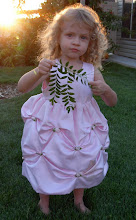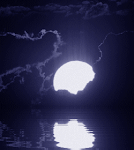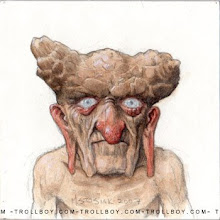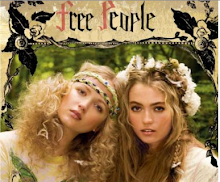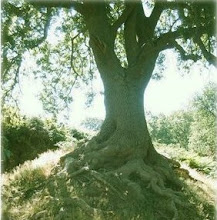 Here is another version of this popular vampire fantasy: Movie Review: The Twilight Saga: New Moon.
Here is another version of this popular vampire fantasy: Movie Review: The Twilight Saga: New Moon.
Friday, December 11, 2009
More 'New Moon'
 Here is another version of this popular vampire fantasy: Movie Review: The Twilight Saga: New Moon.
Here is another version of this popular vampire fantasy: Movie Review: The Twilight Saga: New Moon.
Monday, November 30, 2009
Fun With New Moon

Here is a comment on II of the Twilight saga of fanciful vampires, "New Moon."
ALICE: Bella, Edward thinks you're dead, and he's going to kill himself! It's just like the end of "Romeo and Juliet," which you happened to be reading earlier in the movie! Who could have foreseen that it would come up again??BELLA: Well, you, with your psychic powers.
ALICE: Yes. Also, anyone who's ever seen a movie before.
ARO: Edward, your girlfriend knows too much. She must be killed.
ALICE: Wait! I had a vision! In the future, Bella is a vampire, too.
EDWARD: Spoiler alert!
ARO: Well, why didn't you say you were thinking of converting? That changes everything! Mazel tov!
BELLA: My parents will be disappointed, but it's for the best. Interfaith marriages are so difficult.
Sometimes nice to have a summary if you don't have time to attend the film.
Friday, November 20, 2009
Defend vs. Destroy
Despite their Dark magic, or perhaps because of it, vampires are vulnerable to the more powerful forms of warding- and (less often) seeking-magic. They cannot be destroyed by magic, however. Well-made wards created by reputable magicians are generally sufficient to protect homes, modes of transportation, and places of business. Personal wards are somewhat effective but can be overpowered in a determined attack. Garlic and holy items (such as crosses) are only the most well-known or traditional elements of an effective ward. Nocturnal predators relying on secrecy, vampires avoid large groups and bright lights. Reports indicate that as more vampires hunt in packs, however, they are more willing to attack greater numbers of humans and in more exposed settings.
Defense against a vampire attack once initiated is much more problematic than the prevention or avoidance of such an attack. Silver bullets are only slightly more effective against vampires than are regular bullets (in contrast to their destructive effect on lycanthropes), unless directly striking the heart. Vampires are by nature so much stronger and faster than humans that staking is virtually never effective during the vampire's nocturnal phase, and attempts usually end in the death of the human defender. Vampires are able to heal quickly even from major wounds. Staking, beheading, or burning by fire or exposure to direct sunlight are the only ways vampires may be destroyed or reach "the final death," as some call it.
Vampire hunting, or deliberately seeking contact with vampires in order to destroy them, is extremely dangerous and should be engaged in only by trained, licensed law enforcement professionals or special military units.
I realize that vampires are dangerous, but it still seems that there must be a way for us to defend ourselves without destroying them. Surely some are worth saving.

Wednesday, October 21, 2009
Tuesday, September 22, 2009
Demons and Sorcery
According to most religions, demons are spirits who picked the wrong side in the primordial conflict, and who are now trying in their various ways to deal with their unembodied situation. Demons have always been problematic to the living. Some are relatively harmless, like one I've treated who lived long enough with its human host to absorb a moral sense and to develop a philosophical interest in its own predicament, as well as taking on components of its host’s identity. Some demons, however, are just out to do major damage to all things human, like their titular head.
The difficult thing with demonic possession is to be sure it really is OK with the host. I wouldn’t choose it myself, but hosts sometimes welcome their demons. The demonic dyad allows both human and demon to experience what neither is capable of alone: material, corporeal existence, however brief, along with shared consciousness and uninterrupted metaphysical memory from before the beginning.
Demonic possession of other living creatures is problematic as well. I know of one family whose dog made prophecies, all of which came true. Difficulties arose because the prophecies were things of interest only to a dog, such as that a troublesome cat would soon be moving into the neighborhood, or that there would shortly be a change in his brand of dog chow. The family found it disconcerting enough to get rid of the dog; with Humane Society help he was successfully (and usefully) placed with the owner of a kennel. Disembodied demons can haunt a place, and sometimes it is hard to tell if the haunting is demonic or ghostly. Ghosts won’t possess a person or anything else. They are usually just hanging around trying to get something finished before they move on to the next phase.
Demons are much scarier than ghosts. Sorcerers invoke the demonic by offering corporeality as the bait and then attempting to control the powers they call through black magic. It isn’t the only magic they use, but it is what makes them by definition sorcerers rather than simply magicians or wizards. Sorcery is extremely dangerous and unpredictable. A sorcerer might spend weeks or months calling a particular demon, only to have it, or another, respond unexpectedly. If the demon called is malevolent—and most are—sorcery lays the way open for it to enter the natural, material world and wreak havoc.
No wonder sorcery is illegal.
Monday, September 7, 2009
"What is it Like?"
"What is it like?”
“What is it like. At first it was like being a vegetarian with an insatiable appetite for red meat. You can’t believe what you’re doing, what you must do to maintain your—existence. You try not to do it. You try to find ways to minimize the damage, to do as little harm as possible... So you swear off live blood. Or you take only from the willing. But of course you do damage. It’s your nature—you are a dealer of death and destruction. You swear off blood altogether. You starve until you’re ravenous, a sick, weak animal. And then you come upon a human—even sick and starving, you’re stronger than they are—and you can’t control how you feed. You are nothing but the Thirst. Any humanity, any consciousness, is burnt away in the fever for blood.”
“The Thirst?”
“Food and drink and sex all mixed into one. And sin, and death, and hell. The certain knowledge that if you are destroyed it is the cold dark or the fire.”
“Do you know?”
“I know who I am, what I am. But if there’s anything after destruction—ask the demons.”
“God help you.”
“Don’t let me mislead you. Plenty of people envy the vampires, want to be one of the Undead. I did when I was human. There’re many volunteers. The vampires are beautiful and strong. And they have one huge advantage over humans. They’re heartless. They don’t care anymore—they have nothing to care with. They’ve moved beyond caring. They’re invincible. Nothing touches them. Nothing hurts them.”
Patently untrue, as this vampire no longer exists. But his responses to my questions still haunt me.
Sunday, August 16, 2009
More Garden Faeries
Sunday, August 9, 2009
"Cure" For the Bite of a Vampire
Between the first bite and the last is a sort of twilight phase or fugue state. These victims are under vampiric influence to a degree, without being either killed or Turned. Theoretically, this phase could continue indefinitely, perhaps long enough to justify the rumors of immortal human companions to the vampires. A person may be bitten once without apparent ill effect, but is thereafter vulnerable to influence by their attacker--and that influence, however slight, may manifest years later. The use of holy water, the holy cross, or other similar religious object may help to 'cleanse' the bite, but only if the victim believes in its efficacy. The bite and its effects disappear if at any point the attacking vampire is destroyed.
[emphasis mine] As a therapist, it is extremely difficult to consider that there is no other cure.
Wednesday, August 5, 2009
Common Garden Faery
 To my delight, I have discovered a garden faery in our neighborhood.
To my delight, I have discovered a garden faery in our neighborhood. Initially shy and stand-offish, and hiding from humans,
Initially shy and stand-offish, and hiding from humans, as with most faeries, encouragement, attention, gifts, and a non-threatening approach have really brought out the inner Faery Star!
as with most faeries, encouragement, attention, gifts, and a non-threatening approach have really brought out the inner Faery Star! Although faeries can be somewhat demanding* (and confusing) in their relationships with us mere mortals, I hope to see more of this cute little faery in our garden.
Although faeries can be somewhat demanding* (and confusing) in their relationships with us mere mortals, I hope to see more of this cute little faery in our garden.*"A mischievous fairy is the source of the curse placed on the young woman"
For Those Determined to Read Vamp-Fic

For a more or less accurate and thinly-disguised account of a possible relationship with a vampire, read Robin McKinley's Sunshine.
From Publishers Weekly
Buffyesque baker Rae "Sunshine" Seddon meets Count Dracula's hunky Byronic cousin in Newbery-Award-winner McKinley's first adult-and-then-some romp through the darkling streets of a spooky post-Voodoo Wars world. Now that human cities have been decimated, the vampiric elite holds one-fifth of the world's capital, threatening to control all the earth in less than 100 years, unless human SOFs (Special Other Forces) can hold them at bay by recruiting Sunshine, daughter of legendary sorcerer Onyx Blaise. As breathlessly narrated by Sunshine herself, the Cinnamon Roll Queen of Charlie's Coffeehouse, in the inchoate idiom of Britney, J. Lo and the Spice Girls, Sunshine's coming-of-magical-age launches when she is swarmed by noiseless vampires one night and chained in a decrepit ballroom as an entr‚e for mysterious, magnetic, half-starved Constantine, a powerful vampire whose mortal enemy Bo (short for Beauregard) shackled him there to perish slowly from daylight and deprivation. Most of the charm of this long venture into magic maturation derives from McKinley's keen ear and sensitive atmospherics, deft characterizations and clever juxtapositions of reality and the supernatural that might, just might, be lurking out there in "bad spots" right around a creepy urban corner or next to a deserted lake cabin. McKinley knows very well-and makes her readers believe-that "the insides of our own minds are the scariest things there are."
From Booklist
Rae Seddon, nicknamed Sunshine, lives a quiet life working at her stepfather's bakery. One night, she goes out to the lake for some peace and quiet. Big mistake. She is set upon by vampires, who take her to an old mansion. They chain her to the wall and leave her with another vampire, who is also chained. But the vampire, Constantine, doesn't try to eat her. Instead, he implores her to tell him stories to keep them both sane. Realizing she will have to save herself, Sunshine calls on the long-forgotten powers her grandmother began to cultivate in her when she was a child. She transforms her pocketknife into a key and unchains herself--and Constantine. Surprised, he agrees to flee with her when she offers to protect him from the sun with magic. They escape back to town, but Constantine knows his enemies won't be far behind, which means that he and Sunshine will have to face them together. A luminous, entrancing novel with an enthralling pair of characters at its heart.
Aside from a few unbelievable flights-of-fancy (magical protection from sunlight, for example), the story is a fairly accurate representation of what could happen in a relationship between a person with Fey ancestry and an ambivalent vampire.
Monday, August 3, 2009
Werewolf Moon

We are currently at 96% full of the Waxing Gibbous Moon, which means that the danger of werewolf attack is at its height. For those who are not adequately briefed on the current phase of the moon, moonconnection.com offers a fairly simple diagram and description:
Precautions are in order from the night before through the night after the full moon....the new moon occurs when the moon is positioned between the earth and sun. The three objects are in approximate alignment (why "approximate" is explained below). The entire illuminated portion of the moon is on the back side of the moon, the half that we cannot see.
At a full moon, the earth, moon, and sun are in approximate alignment, just as the new moon, but the moon is on the opposite side of the earth, so the entire sunlit part of the moon is facing us. The shadowed portion is entirely hidden from view.
The first quarter and third quarter moons (both often called a "half moon"), happen when the moon is at a 90 degree angle with respect to the earth and sun. So we are seeing exactly half of the moon illuminated and half in shadow.
Once you understand those four key moon phases, the phases between should be fairly easy to visualize, as the illuminated portion gradually transitions between them.
An easy way to remember and understand those "between" lunar phase names is by breaking out and defining 4 words: crescent, gibbous, waxing, and waning. The word crescent refers to the phases where the moon is less that half illuminated. The word gibbous refers to phases where the moon is more than half illuminated. Waxing essentially means "growing" or expanding in illumination, and waning means "shrinking" or decreasing in illumination.
Thus you can simply combine the two words to create the phase name, as follows:
After the new moon, the sunlit portion is increasing, but less than half, so it is waxing crescent. After the first quarter, the sunlit portion is still increasing, but now it is more than half, so it is waxing gibbous. After the full moon (maximum illumination), the light continually decreases. So the waning gibbous phase occurs next. Following the third quarter is the waning crescent, which wanes until the light is completely gone -- a new moon.

Wednesday, July 29, 2009
Second Report from the Congressional Committee on Non-Human Involvement in the Global Economy
Chilling.There is no vampire society as humans understand the term. Vampire language or culture is an amalgam of the affiliated vampires’ original language(s) and culture(s), plus the exigencies of vampiric nature itself. “Affiliation” here is loosely used. Vampires are either solitary hunters or organized in small packs with very old, very powerful vampires at the head of each gang or fiefdom. Archaic languages or cultural artifacts may be incidentally preserved in this way (but unfortunately remain unavailable to human scholarly examination).
Alliances between powerful vampires of equal status are rare. Love relationships are not believed to occur between vampires. Exceptions are occasionally reported, but have not been substantiated. The relationship of vampire to vampire is competitive and usually hostile or exploitive; vampire society appears to observers to be entirely parasitic, hierarchical, and power-driven.
Inter-vampire aggression may impinge upon humanity in the following ways: when one solitary vampire moves in on another’s territory, upsetting the original vampire’s routine of hidden predation; or when two (or more) vampire packs begin a war as a part of a dominance contest between ancient and powerful gang leaders and their adepts and acolytes.
Older or more powerful vampires may have a retinue or entourage of more recently Turned vampires which they support and protect (in a fashion) and upon which they depend for obtaining human victims and psychic energy. This entourage has sometimes been found to include human and other preternatural “pets,” “servants,” or “companions” who are tapped for blood but who do not usually die immediately. It is rumored that minimal but continued blood contribution in such a situation may result in a greatly extended lifespan for the human, as well as the gain of unspecified preternatural powers. Fortunately, although misguided or mentally ill humans might seek to join a vampire entourage in this type of relationship, it is evidently rare, and available only to or with master vampires. There is some indication that rumors about the existence of immortal human companions may be deliberately encouraged by vampires to maintain a supply of volunteers. True or not, humans in such mutually parasitic or symbiotic relationships with vampires are lost to their former lives.
Despite the lack of a cooperative society, vampires appear to have paralleled or in several instances proportionally surpassed human economic and scientific endeavor. Vampire science and technology focus on many of the same issues as human science. Medical research continues in two main areas: that of blood (from synthesizing whole blood substitutes to isolating specific properties relevant to nutrition, regeneration, telepathic communication, and hypnosis), and particularly that of protection from sunlight. All vampires possess at least a modicum of Dark magic, unlike humans, in whom substantive magical ability is rare without at least some “fey” inheritance (English vernacular—see companion Fact Sheet Magical Creatures of Northwest Europe—such creatures in other geographic and/or cultural regions are variously denoted according to language). The combination of wizardry, fierce competitiveness, and the wealth and information acquired by powerful survivors during centuries-long existence, makes emerging vampire science and technology a creditable threat to human society.
Thursday, July 2, 2009
Support Organization for Ghosts and Haunts
P.S. The AAAGH's local representative asks me to "remind interested persons to please show respect for our site and don't disturb the human caretaker who is resident (and hopefully sleeping) at that hour. McCune Mansion staff have had difficulty in the past with group members moaning, depositing ectoplasm, dripping blood, and clanking chains in such a manner as to jeopardize the support group's welcome there. Remember, the group is for our benefit and it doesn't help to frighten the sponsor away."
Wednesday, July 1, 2009
Buffy vs. Edward
Saturday, January 31, 2009
Twilight Spoof
How Many Vampires Exist?
Unknown. Prior to the Attacks of October, vampires were believed to be extremely rare in this country. Estimates now range from one or two to several dozen per major metropolitan area. The Attacks proved that a very small number of vampires can cause immense damage to the national economy—with severe disruptions to business, societal, and governmental functioning—while causing relatively few deaths and little property damage. Perhaps the greatest harm from the Attacks and their aftermath has been to the societal intangibles of safety, morale, and freedom.
A Vamp By Any Other Name...
...these creatures generally call themselves “vampires,” although they have expressed no objection to the slightly inaccurate term “immortal.” It is a recent pretension for them to refer to themselves as “post-human.”More from the Congressional Committee on Non-Human Involvement in the Global Economy.
Why Do Vampires Appear Only At Night?
Current knowledge indicates that vampires fall into a coma-like sleep at the rising of the sun, and awaken only after the sun sets. Despite some reports to the contrary, this appears to be universal. How close to sunrise the comatose state begins and how soon after sunset it ends depends on the individual vampire. Direct sunlight destroys any vampire. It is unknown whether vampires seek cover because of their involuntary comatose state during the sunlight hours, and choose entombment or burial for the purpose of seclusion and protection against attack, or if burial is necessary for other reasons, such as rejuvenation. It is not known if coffins lined with earth, contact with earth, or protection by earth are necessary. Vampire sources of information on this matter are unreliable at best.Note that the following photo is obviously not of a vampire. There are several cues: one that the picture was taken in full daylight, two that the supposed "fangs" appear to be candy corn, and three that it is a photo (it is impossible to capture an image of a vampire, whether in a mirror, on camera, or with any form of media--except audio media, interestingly).

Wednesday, January 14, 2009
Vampire Personality Characteristics
What are vampire personality characteristics?
As far as is known, all vampires were originally human and mortal. Humans vary in terms of personality structure and functioning, and much of that variance remains after the newly dead human rises again as a vampire. There are personality similarities between vampires, however, which can be accounted for by the fact of vampirism itself. These are summarized below.Paranoia. Due to their status as predator to human prey, and the consequent antipathy between mortal victims and the few immortal hunters, vampires must remain hidden, undiscovered, and defended, their true natures and behavior patterns unrevealed. They are therefore secretive, suspicious, watchful, guarded, and hostile toward humans and other vampires.
Aggressiveness. Vampires view humanity in general as dangerous prey, with all the thrill and savor of the hunt, the chase, and the capture. Toward captured human victims, however, they apparently exhibit the attitude of exploitative indifference that most humans have for their food-animals. Vampires reserve most of their aggressive attention for each other. Rarely, they may express a “higher order” affection for their prey (see below).
Parasitism. As literal parasites, vampires depend on the blood of their victims for their continued existence. They are almost always also psychically parasitic upon selected victims in a manner similar to that of some personality disordered humans. Most experts believe that vampires may be able to achieve a semblance of love or relationship with humans during the parasitic phase before the death of the victim, but only with the imbibing or the exchange of blood. Older vampires may need less blood less often. Blood-taking often occurs without the victim’s conscious knowledge—which partially accounts for the severe underestimation of vampire activity in this country prior to the Attacks of October. In those infrequent instances when a victim has survived a first attack and also been aware of and reported the vampire’s visit, it is evident that the virulent phase of psychic parasitism begins immediately. Vampires may attach themselves for long periods to one “love” object, as do their lesser demonic cousins, the incubi and succubae, until the victim is either Turned or permanently dead.Ennui, Depression, and Suicidality. An undetermined but probably significant minority of new vampires commit suicide immediately upon recognizing their condition, usually by self-immolation in direct sunlight. Others may refuse to feed, and so fade, but this intent to cause no harm may backfire as the vampire will have less control over the blood lust the longer starvation continues. “Going to earth” or “returning to earth” are the usual vampiric terms for a prolonged voluntary comatose state which can result from injury, defeat by an enemy, or from what would be labeled in humans as depression. Some vampires eventually emerge; some do not. Even vampires who were initially enthusiastic about their new powers may eventually find themselves bored with or tired of the relentlessly aggressive vampire social structure. Vampire duels and challenges, especially against a much more powerful foe, may be a form of suicide for some.
Monday, January 12, 2009
"Bad Boy" Appeal
http://current.com/items/89591135/target_women_vampires.htm
Sunday, January 11, 2009
New Government Fact Paper on Vampires
Where do vampires come from?
All vampires are created from humans. There are no “born” vampires. Vampires insist that humans cannot be Turned against their will—a human must ask to go under the Dark to rise as a vampire. This may be a matter of semantics, however; the vampire mojo—amplified by eye contact, breath, or physical touch—may greatly reduce or eliminate a human victim’s ability to resist. In addition, Turning is often or always requested and accomplished at the point of death, when becoming a vampire is the only alternative.
Vampires may feed upon and kill a human at first approach, or may return over a period of time, generally during the person’s sleep or while they are alone and in an amnesic, hypnotic state. Such return visits eventually end in death, most frequently by blood loss, sometimes by accident or injury under circumstances unrelated to the vampire’s attention. Most often the victim truly dies. Less frequently the newly dead individual rises at sunset (or in three days—reports vary) as a vampire. Folklore suggests that the victim must also drink the blood of the vampire to be Turned, but exceptions to this “rule” have been reported. Despite speculation, it is unknown at this time why some rise and some do not. The specific infectious agent—viral, demonic, or extraterrestrial have all been proposed—is also unknown. Any deceased individual suspected to have been vampire prey, or corpse found with the marks of a vampire on it, is by legal mandate staked, decapitated, and cremated. Many people now specifically request such postmortem care regardless of the cause of death to prevent even the possibility of rising as one of the Undead.
Of course these publicly-released reports are cautious in their statements. But it is always amazing to me how little we actually know about these creatures who walk among us.

Tuesday, January 6, 2009
Why Aren't We Worrying About This?
After the human race is enslaved by robots, there are going to be small rebel groups hiding out somewhere and Elliot Spitzer’s going to be writing op-eds about how “no one could have predicted” that the robots would rebel and overthrow their masters. And it’ll be left to DFH bloggers to observe that this is in fact one of the most widely predicted scenarios in all of science fiction. From the proto-SF of Mary Shelly’s Frankenstein through to Karel Capek’s R.U.R. and The War Against the Newts all the way up through Terminator and The Matrix. Yes, yes, yes eventually the Butlerian Jihad will allow us to re-overthrow the Thinking Machines and establish human rule but do we really want to fall into that trap?
Just say no to robots. And certainly say no to robots in our schools.

I can only agree. We cannot be too careful regarding this threat.





